E-commerce in Europe has been steadily developing since the mid 90s and despite occasional slowdowns, such as that experienced last year, it is expected that this will continue to be the engine for CEP growth. In particular, out of home (OOH) delivery which makes e-commerce (and even more so, re-commerce) more financially viable is expected to benefit.
Consumers are clearly turning to re-commerce platforms such as Vinted, OLX or eBay with low price and sustainability apparently being the main factors behind this move. The trend is also supported on the supply side by more brands moving into re-commerce; indeed, several retailers have launched take-back schemes, in which customers can trade in old apparel in return for a voucher to spend in store or a donation to a worthy cause. This is expected to further increase the importance of OOH, as low-value C2C shipments are financially untenable via door-to-door delivery, which can often cost more than the item being delivered.
Given the importance of OOH, Last Mile Experts (LME) has just published the third edition of its benchmark European Out of Home report. Based on the minimum viable product (MVP) rule, a network should have at least 1 point per 10,000 inhabitants. As we can see, below, most countries have now exceeded this level, the only issue being that in many cases, networks are fragmented and often suboptimal. According to the report, Poland has overtaken the Czech Republic and Denmark to become the European leader in terms of OOH density with almost 40 points per 10,000 inhabitants.

In this year’s report, LME noted 120,390 unique APMs, which is 51% up on 2021 while the total number of PUDO points grew less dynamically, by 7% year on year, albeit from a much higher base.
Europe’s key unique PUDO markets are:
Germany – 51,090
France – 49,200
Italy – 47,740
UK – 45,340
Poland – 29,520
Key unique APM markets:
Poland – 28,880
UK – 15,460
Germany – 13,450
France – 8,750
Czech Republic – 7,480
Unsurprisingly, Poland (powered by InPost) has the most APMs in Europe, beating the second market, the UK, by over 85%. Having said that, PUDOs still have the greatest impact on the number of OOH delivery points and density, although lockers are growing in importance. Last Mile Experts’ research has shown that OOH is increasingly important in many EU markets – with OOH already considered to make up over 50% of deliveries in the Nordics, France, Germany, the Baltics, the Czech Republic and Poland.
Moreover, many industry experts expect an increase in the percentage of B2C parcels going through OOH for the following reasons:
- As the proximity of points increases, OOH becomes more convenient and closer to a home delivery, or to coin a bpost phrase, the access point is “slipper distance” from home.
- Capacity demands make this the only viable or cost-effective option, especially for the increasingly important re-commerce sector.
- Ecological matters favor OOH delivery where a network is efficient.
Of course, some segments will still require home delivery, such as heavy and bulky items, premium ‘on demand’ items and e-grocery services. For these to be more efficient, there is a need to develop new technologies such as smart locks (e.g. Amazon Key) for in-home delivery, and cost-effective refrigerated lockers or robots to make ‘click and collect’ more effective.
Notwithstanding the above, lockers and PUDOs have become a key element of any effective last-mile delivery network and those players who are able to offer effective OOH delivery options will be the winners in the ‘new last mile’.
To find out more about OOH in Europe and the UK, download the Last Mile Experts 2023 report for free by clicking here.


